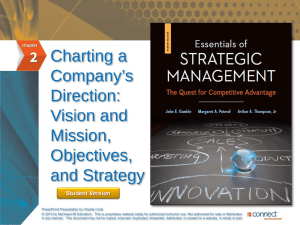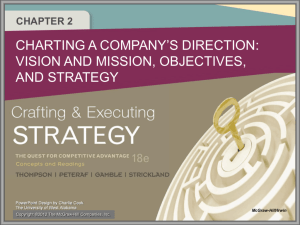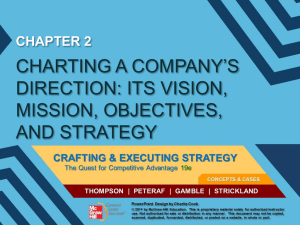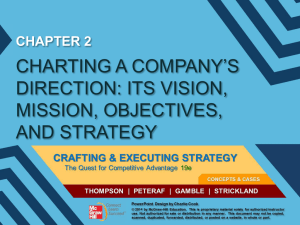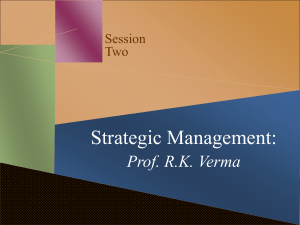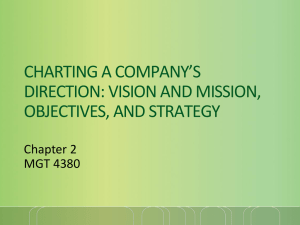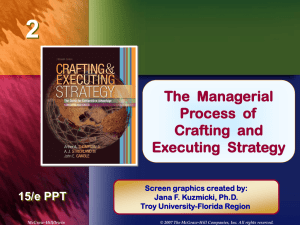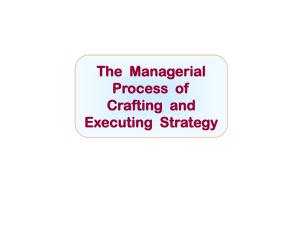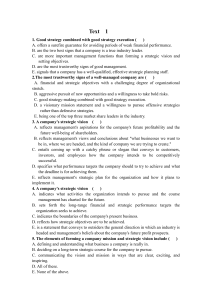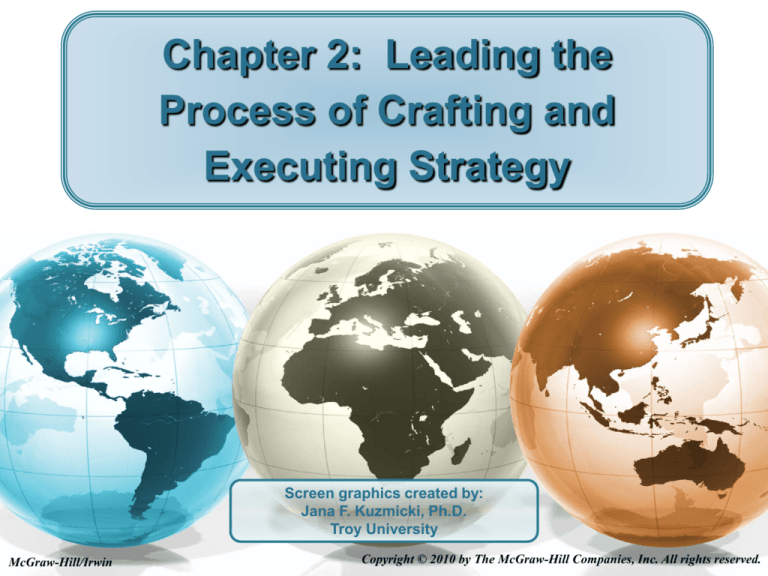
Chapter 2: Leading the
Process of Crafting and
Executing Strategy
Screen graphics created by:
Jana F. Kuzmicki, Ph.D.
Troy University
McGraw-Hill/Irwin
Copyright © 2010 by The McGraw-Hill Companies, Inc. All rights reserved.
“If you don’t know where
you are going, any road
will take you there.”
Cheshire Cat to Alice
Lewis Carroll, Alice in Wonderland
“If you articulate a vision
that makes people passionate,
there are so many amazing
things you can do.”
Dr. Sophie Vandebroek
Xerox Corporation
Chapter Learning Objectives
1. Grasp why it is critical for company managers to think long and
hard about where a company needs to head and why.
2. Understand the importance of setting both strategic and financial
objectives.
3. Recognize that the task of crafting a company strategy draws on
the entrepreneurial talents of managers at all organizational
levels.
4. Understand why the strategic initiatives taken at various
organizational levels must be tightly coordinated to achieve
companywide performance targets.
5. Become aware of what a company must do to achieve operating
excellence and to execute its strategy proficiently.
6. Understand why the strategic management process is ongoing,
not an every-now-and-then task.
7. Learn what leadership skills management must exhibit to drive
strategy execution forward.
8. Become aware of the role and responsibility of a company’s
board of directors in overseeing the strategic management
process.
2-4
Chapter Roadmap
What Does the Strategy-Making, Strategy-Executing
process Entail?
Phase 1: Developing a Strategic Vision
Phase 2: Setting Objectives
Phase 3: Crafting a Strategy
Phase 4: Implementing and Executing the Strategy
Phase 5: Evaluating Performance and Initiating
Corrective Adjustments
Leading the Strategic Management Process
Corporate Governance: The Role of the Board of
Directors in the Strategy-Making, Strategy-Executing
Process
2-5
Figure 2.1: The Strategy-Making, Strategy-Executing Process
2-6
Developing a Strategic Vision
Phase 1
Involves thinking strategically about
Future direction of company
Changes in company’s
product/market/customer technology to improve
Current market position
Future prospects
A strategic vision describes the route a company
intends to take in developing and strengthening
its business. It lays out the company’s strategic
course in preparing for the future.
2-7
Table 2.1: Factors to Consider in Deciding on a Company’s Future Direction
2-8
Key Elements of a Strategic Vision
Delineates management’s aspirations for the
business
Provides a panoramic view of “where we are going”
Charts a strategic path
Is distinctive and specific to
a particular organization
Avoids use of generic language that
is dull and boring and that could
apply to most any company
Captures the emotions of
employees and steers them
in a common direction
Is challenging and a bit beyond a
company’s immediate reach
2-9
Role of a Strategic Vision
A well-conceived, well-communicated vision
functions as a valuable managerial tool to
Give the organization a sense of direction, mold
organizational identity, and create a committed
enterprise
Illuminate the company’s directional path
Provide managers with a reference point to
Make strategic decisions
Translate the vision into hard-edged
objectives and strategies
Prepare the company for the future
A strategic vision exists only as words and has no
organizational impact unless and until it wins the commitment
of company personnel and energizes them to act in ways that
move the company along the intended strategic path!
2-10
Table 2.2: Characteristics of an Effectively Worded Vision Statement
2-11
Table 2.3: Common Shortcomings in Company Vision Statements
2-12
Example of Strategic Vision
Red Hat
To extend our position as the most trusted
Linux and open source provider to the
enterprise. We intend to grow the market
for Linux through a complete range of
enterprise Red Hat Linux software, a
powerful Internet management platform,
and associated support and services.
2-13
Example of Strategic Vision
UBS
We are determined to be the best global financial services company.
We focus on wealth and asset management, and on investment
banking and securities businesses.
We continually earn recognition and trust from clients, shareholders,
and staff through our ability to anticipate, learn and shape our future.
We share a common ambition to succeed by delivering quality in what
we do.
Our purpose is to help our clients make financial decisions with
confidence.
We use our resources to develop effective solutions and services for
our clients.
We foster a distinctive, meritocratic culture of ambition, performance
and learning as this attracts, retains and develops the best talent for
our company.
By growing both our client and our talent franchises, we add
sustainable value for our shareholders.
2-14
Examples of Strategic Visions
Caterpillar
Be the global leader in customer value.
eBay
Provide a global trading
platform where practically anyone
can trade practically anything.
2-15
Strategic Vision vs. Mission
A strategic vision
concerns a firm’s future
business path - “where
we are going”
Markets to be pursued
A company’s mission
statement typically
focuses on its present
business purpose - “who
we are and what we do”
Future product/market/
customer/technology focus
Current product and
service offerings
Kind of company
management is
trying to create
Customer needs and
customer groups being
served
Geographic
coverage
2-16
Characteristics of a Mission Statement
Identifies boundaries of a company’s current
business and says something about
Present products and services
Types of customers served
Geographic coverage
Conveys
Who we are,
What we do, and
Why we are here
A good mission statement describes a company’s business
makeup and purpose in language specific enough to give
the company its own identity and distinguish it from
other enterprises in the same or other industries!
2-17
Key Elements of a
Mission Statement
A complete mission statement should cover three
things:
Customer needs being met –
What is being satisfied
Customer groups or markets being served –
Who is being satisfied
What the organization does (in terms of business
approaches, technologies used, and activities
performed) to satisfy the targeted needs of the
targeted customer groups –
How customer needs are satisfied
A company’s mission is not to make a profit! Its true
mission is its answer to “What will we do to make a profit?”
Making a profit is an objective or intended outcome!
2-18
Mission Statement: Trader Joe’s
(a unique grocery store chain)
To give our customers the best food and beverage
values that they can find anywhere and to provide
them with the information required for informed
buying decisions. We provide these with a dedication
to the highest quality of customer satisfaction
delivered with a sense of warmth, friendliness, fun,
individual pride, and company spirit.
2-19
Mission Statement: OSHA
Occupational Safety and Health Administration
To promote the safety and health of America’s
workers by setting and enforcing standards;
Providing training, outreach, and education;
Establishing partnerships;
Encouraging continual process improvement in
workplace safety and health.
2-20
Linking the Vision
with Company Values
Companies often develop a statement of values to guide a
company’s pursuit of its vision and strategy and paint the white
lines for how a company’s business is to be conducted
Company values statements typically
contain four to eight beliefs, traits, and
behaviors relating to such things as
Fair treatment, integrity, ethical behavior,
innovation, teamwork, product quality, customer satisfaction,
social responsibility, community citizenship
But values statements remain a bunch of nice words until
espoused beliefs, traits, and behaviors are
Incorporated into company’s operations and work practices
Used as benchmarks for job appraisal, promotions, and
rewards
If company personnel are not held accountable
for displaying company values in doing their jobs, then the
company values statement is a bunch of empty words!
2-21
Example: American Express’
Company Values
Customer
commitment
Quality and
Integrity
Respect
for people
Teamwork
2-22
Example: Toyota’s Company Values
Respect for and development of employees
Teamwork
Getting quality right the first time
Learning
Continuous improvement
Embracing change in pursuit of low-cost, top-notch
manufacturing excellence in motor vehicles
2-23
Example: DuPont’s Company Values
Safety
Ethics
Respect
for people
Environmental
stewardship
2-24
Example: Abbott Laboratories’
Company Values
Pioneering
Achieving
Caring
Enduring
2-25
Example: Yahoo’s Core Values
Excellence – Committed to winning with integrity.
Innovation – Thrive on creativity an ingenuity.
Customer Fixation – Respect our customers above all else.
Teamwork – Treat one another with respect and communicate openly.
Community – Share an infectious sense of mission to make an impact on
society.
Fun – Believe humor is essential to success.
What Yahoo Doesn’t Value – Singles out 54 things it does not value – losing,
bureaucracy, “good enough,” arrogance, status quo, formality, quick fixes …
2-26
Communicating the Strategic Vision
Winning support for the vision involves
Putting “where we are going and why” in writing
Distributing the statement organization-wide
Having executives explain vision to employees
An engaging, inspirational vision
Challenges and motivates workforce
Articulates a compelling case
for where company is headed
Evokes positive support and excitement
Arouses a committed organizational
effort to move in a common direction
2-27
Capturing the Vision in a Slogan
FedEx
“Satisfying worldwide demand for fast,
time-definite, reliable distribution.”
Home Depot
“Helping people improve the
places where they live and work.”
2-28
Capturing the Vision in a Slogan
Scotland Yard
“To make London the safest
major city in the world.”
Charles Schwab
“To provide customers with
the most useful and ethical financial
services in the world.”
2-29
Recognizing Strategic Inflection Points
Sometimes an order-of-magnitude change occurs in
a company’s environment that
Dramatically alters its future prospects
Mandates radical revision of its strategic course
Critical decisions have to be made about where to
go from here
A major new directional path may have to be taken
A major new strategy may be needed
Responding quickly to unfolding changes in the
marketplace lessons a company’s chances of
Becoming trapped in a stagnant business or
Letting attractive new growth opportunities slip away
2-30
Intel’s “Strategic
Inflection Points”
Prior to mid-1980s
Focus on memory chips
Starting in mid-1980s
Abandon memory chip business (due to lower-cost
Japanese companies taking over the market) and
Become preeminent supplier of microprocessors to PC
industry
Be undisputed leader in driving
PC technology forward
1998
Shift focus from PC technology to becoming the
preeminent building block supplier to Internet
economy
2-31
Overcoming Resistance to
a New Strategic Vision
Mobilizing support for a new vision entails
Reiterating basis for the new direction
Addressing employee concerns head-on
Calming fears
Lifting spirits
Providing updates and progress
reports as events unfold
2-32
Test Your Knowledge
The difference between a company's mission statement and
the concept of a strategic vision is that
A. the mission statement lays out the desire to make a profit,
whereas the strategic vision addresses what strategy the
company will employ in trying to make a profit.
B. a mission statement deals with “where we are headed ”
whereas a strategic vision provides the critical answer to
“how will we get there?”
C. a mission deals with what a company is trying to do and a
vision concerns what a company ought to do.
D. a mission statement typically concerns an enterprise’s
present business scope and purpose—“who we are, what we
do, and why we are here”—whereas the focus of a strategic
vision is on the direction the company is headed and what
its future product-customer-market-technology focus will be.
E. a mission is about what to accomplish for shareholders
whereas a strategic vision concerns what to accomplish for
customers.
2-33
Payoffs of a Clear Strategic Vision
Crystallizes an organization’s long-term
direction
Reduces risk of rudderless decision-making
Creates a committed enterprise
where organizational members
enthusiastically pursue efforts to
make the vision a reality
Provides a beacon to keep strategy-related
actions of all managers on common path
Helps an organization prepare for the future
2-34
Setting Objectives
Phase 2
Purpose of setting objectives
Converts vision into specific performance targets
Creates yardsticks to track performance
Well-stated objectives are
Quantifiable
Measurable
Contain a deadline for achievement
Spell-out how much of what kind
of performance by when
2-35
Importance of Setting
Stretch Objectives
Objectives should be set at levels that
stretch an organization to
Perform at its full potential,
delivering the best possible results
Push firm to be more inventive
Exhibit more urgency to improve its business
position
Be intentional and focused in its actions
There’s no better way to avoid ho-hum results than
by setting stretch objectives and using compensation
incentives to motivate organization members to
achieve the stretch performance targets!
2-36
Types of Objectives Required
Financial Objectives
Strategic Objectives
Outcomes focused
on improving financial
performance
Outcomes focused on
improving competitive
strength and market
standing
$
2-37
Examples: Financial Objectives
Annual revenue growth of X%
X % increase in after-tax profits annual
Earnings per share growth of X% annually
Annual dividend increases of X%
Profit margins of X%
X% return on capital employed (ROCE)
Annual stock price increases that average X% over
time
Strong bond and credit ratings
Sufficient internal cash flows to fund 100% of new
capital investment
Stable earnings during periods of recession
2-38
Examples: Strategic Objectives
Winning an X% market share within 3 years
Achieving lower overall costs than rivals
Overtaking key competitors on product performance
or quality or customer service within 2 years
Deriving X% of revenues from sale of new products
introduced in past 5 years
Being the recognized industry leader in product
innovation and/or technological know-how
Having a wider product line than rivals
Consistently getting new or improved products to
market ahead of rivals
Having stronger national or global sales and
distribution capabilities than rivals
2-39
Good Strategic Performance Is the Key
to Better Financial Performance
Achieving good financial performance is not enough
Current financial results are “lagging indicators” reflecting
results of past decisions and actions — good profitability now
does not translate into stronger capability for delivering even
better financial results later
However, setting well-chosen strategic
objectives and achieving them signals
Growing competitiveness
Growing strength in the marketplace
A company that is growing competitively stronger is
developing the capability for better financial performance
in the years ahead
Good strategic performance is thus a “leading indicator” of a
company’s capability to deliver improved
future financial performance
Unless a company sets and achieves stretch strategic objectives
it is not developing the competitive muscle to deliver even
better financial results in the years ahead!
2-40
A Balanced Scorecard Approach –
Setting Strategic and Financial Objectives
A balanced scorecard for measuring
company performance is optimal; it entails
Setting financial and strategic objectives
Placing balanced emphasis on achieving
both types of objectives
(However, if a company’s financial performance is dismal or if its very
survival is in doubt because of poor financial results, then stressing
the achievement of the financial objectives and temporarily deemphasizing the strategic objectives may have merit)
Just tracking financial performance overlooks the
importance of measuring whether a company is
strengthening its competitiveness and market
position
The surest path to sustained future profitability year after
year is to relentlessly pursue strategic outcomes that
strengthen a company’s business position and give it a
growing competitive advantage over rivals!
2-41
General Motors’ Objectives
Reduce the percentage of automobiles
using conventional internal combustion
engines (ICE) through the development
of hybrid ICEs, plug-in hybrid ICEs,
range-extended electric vehicles, and
hydrogen fuel cell electric engines
Reduce automotive structural costs to
benchmark levels of 23 percent of
revenue by 2012 from 34 percent in 2005
Reduce annual U.S. labor costs by an
additional $5 billion by 2011
2-42
The Home Depot’s Objectives
Be the number one destination for professional
contractors, whose business accounted for
roughly 30 percent of 2006 sales
Improve in-stock positions so customers can find
and buy exactly what they need
Deliver differentiated customer service and the
know-how that our customers have come to
expect from The Home Depot
Repurchase $22.5 billion of outstanding shares
during 2008
Open 55 new store locations with 5 store
relocations in 2008
2-43
The Objectives at Yum! Brands
(KFC, Pizza Hut, Taco Bell)
Open 100 KFC restaurants in Vietnam by 2010
Expand Taco Bell restaurant concept to Dubai, India,
Spain and Japan during 2008 and 2009
Increase number of international restaurant locations
from 12,000 in 2007 to 15,000 in 2012
Increase operating profit from international operations
from $480 million in 2007 to $770 million in 2012
Expand Pizza Hut’s menu to include pasta and chicken
dishes
Decrease the number of company owned restaurant
units in U.S. from 20% of units in 2007 to less than 10%
of units by 2010
Increase the number of Taco Bell units in the U.S. by
2%–3% annually between 2008 and 2010
2-44
Avon’s Objectives
Increase our beauty sales and market
share
Strengthen our brand image
Enhance the representative experience
Realize annualized cost savings of $430
million through improvements in
marketing processes, sales model and
organizational activities
Achieve annualized cost savings of $200
million through a strategic sourcing
initiative
2-45
Test Your Knowledge
Which of the following represents the best
example of a well-stated strategic objective (as
opposed to a well-stated financial objective)?
A. Achieve revenue growth of 150% annually
B. Achieve a AA bond rating within 3 years and an
annual cash flow of $750 million
C. Invest more money in R&D to enable the company to
offer customers the widest selection of products in
the industry
D. Increase market share from 15% to 20% and achieve
the lowest overall costs of any producer in the
industry, both within three years
E. Pay more attention to reducing costs over the next
two years
2-46
For Discussion: Your Opinion
Which matters most to a company’s future
financial performance — setting and pursuing
financial performance targets or setting and
pursuing strategic performance targets?
What arguments support your answer?
2-47
Both Short-Term and Long-Term
Objectives Are Needed
Short-term objectives
Targets to be achieved soon
Milestones or stair steps for reaching long-range
performance targets
Long-term objectives
Targets to be achieved within
3 to 5 years
Calls for actions now that will
permit reaching targeted
long-range performance later
2-48
Concept of Strategic Intent
A company exhibits strategic intent
when it relentlessly pursues an
ambitious strategic objective,
concentrating the full force of its
resources and competitive actions on
achieving that objective!
2-49
Characteristics of Strategic Intent
Indicates firm’s intent to making quantum
gains in competing against key rivals and to
establishing itself as a winner in the
marketplace, often against long odds
Involves establishing a grandiose
performance target out of proportion to
immediate capabilities and market position but
then devoting the firm’s full resources and
energies to achieving the target over time
Entails sustained, aggressive actions to take
market share away from rivals and achieve a
much stronger market position
2-50
Test Your Knowledge
A company pursues strategic intent when
A. it pursues its strategic vision.
B. it crafts a strategy and proceeds to
implement it.
C. it adopts a strategic plan and tries to
execute it.
D. it sets objectives and pursues their
achievement.
E. it relentlessly pursues an ambitious
strategic objective and concentrates its full
resources and competitive actions on
achieving that objective.
2-51
Objectives Are Needed at All Levels
The objective-setting process is more topdown than bottom up
1. First, set organization-wide objectives
and performance targets
2. Next, set business and
product line objectives
3. Then, establish functional
and departmental objectives
4. Individual objectives are established last
2-52
Importance of Top-Down Objectives
Provides guidelines for objective-setting and
strategy-making in lower-level organizational
units
Helps ensure that performance targets set by
business units, divisions, and departments are
directly connected to achieving
company-wide objectives
Top-down objective-setting has
two advantages
Leads to cohesive and compatible objectives
and strategies up and down the organization
Helps unify internal efforts to move
company along the chosen strategic path
2-53
Crafting a Strategy
Phase 3
Strategy-making involves astute
entrepreneurship
Actively searching for opportunities
to do new things
or
Actively searching for opportunities to do
existing things in new or better ways
Strategizing involves
Developing timely responses to happenings
in the external environment
and
Steering company activities in new directions
dictated by shifting market conditions
2-54
Crafting a Good Strategy Requires
Good Business Entrepreneurship
Developing a winning strategy involves
Diagnosing the direction and force of
the market changes underway and making
timely strategic adjustments
Spotting new or better ways
to satisfy customer needs
Figuring out how to outwit and
outmaneuver competitors
Pursuing ways to strengthen the
firm’s competitive capabilities
Proactively trying to out-innovate rivals
2-55
The Role of Astute Entrepreneurship in
Crafting a Company’s Strategy
Masterful strategies come partly (maybe
mostly) by doing things differently from
competitors where it counts
Innovating more creatively
Being more efficient
Being more imaginative
Adapting faster
Rather than running with the herd!
Good strategy-making is therefore
inseparable from good entrepreneurship—
one cannot exist without the other!
2-56
The Hows That Define
a Firm's Strategy
How to grow the business
How to please customers
How to outcompete rivals
How to respond to changing market
conditions
How to manage each functional
piece of the business (R&D, production,
marketing, HR, finance, and so on)
How to achieve targeted levels of
performance
2-57
Who Is Involved in Strategy Making?
CEO (chief executive officer)
Has ultimate responsibility for leading
the strategy-making process
Functions as strategic visionary and
chief architect of strategy
Senior executives
Typically have influential roles in fashioning those strategy
components involving their areas of responsibility
Managers of subsidiaries, divisions, geographic
regions, plants, and other important operating units
(and, often, key employees with specialized expertise)
Some pieces of the strategy are best orchestrated by onthe-scene company personnel with detailed familiarity of
the piece of the business they are in charge of running
2-58
Why Is Strategy-Making Nearly Always
a Collaborative Process?
The job is often way too big for one person or a
small executive group—many strategic issues are
complex or cut across multiple areas of expertise
The more a company’s operations cut across
different products, industries and geographic areas,
the more that headquarters executives
must delegate strategy-making authority
to down-the-line managers in charge
of particular functions and
operating units
In today’s companies every manager typically
has a strategy-making role—ranging from
major to minor—for the area he or she heads!
2-59
For Discussion: Your Opinion
Crafting a company’s strategy is really a job for
senior executives and the company’s board of
directors.
True or false? Discuss and explain.
2-60
Figure 2.2: A Company’s Strategy-Making Hierarchy
2-61
Corporate Strategy
Orchestrated by headquarters executives
and involves
Moves to diversify into different industries
Actions to boost the combined performance
of the company’s different businesses
Actions to capture cross-business synergies
Establishing investment
priorities and steering
corporate resources into the
most attractive businesses
2-62
Business Strategy
Concerns the actions and approaches crafted
to produce successful performance in one
specific line of business. Is usually the
responsibility of the manager in charge of the
business and involves
Crafting competitive moves to build
sustainable competitive advantage
Seeing that lower-level strategies within
the business are well-matched to the
overall business strategy
Gaining approval of business-level strategic
moves by corporate-level officers and directors
2-63
Functional Strategies
Concerns the game plan for a function,
activity, or process within a business; is
usually orchestrated by the functional head
and involves
Crafting functional strategic initiatives
that will support the overall
business strategy
Adding function-related
strategic details to the
overall business strategy
2-64
Operating Strategies
Are generally crafted by frontline managers
(subject to review and approval by higherranking managers)
Concern the relatively narrow strategic
initiatives and approaches for managing key
operating units (geographic regions,
distribution centers, plants) and strategicallyrelevant operating activities (advertising,
supply chain activities, Internet sales)
Add further detail and
completeness to functional
and business strategies
2-65
Levels of Strategy-Making
in a Diversified Company
Corporate-Level
Managers
Corporate
Strategy
Two-Way Influence
Business-Level
Managers
Business Strategies
Two-Way Influence
Functional
Managers
Functional Strategies
Two-Way Influence
Operating
Managers
Operating Strategies
2-66
Levels of Strategy-Making in
a Single-Business Company
Business-Level
Managers
Business
Strategy
Two-Way Influence
Functional
Managers
Functional Strategies
Two-Way Influence
Operating
Managers
Operating Strategies
2-67
Test Your Knowledge
The strategy-making hierarchy in a single business
company consists of
A. it pursues business strategy, divisional strategies,
and departmental strategies.
B. business strategy, functional strategies, and
operating strategies, whereas in a diversified
company it consists of corporate strategy, business
strategies (one for each business the diversified
company is in), functional strategies, and operating
strategies.
C. business strategy and operating strategy.
D. company strategy, divisional strategies, and
functional strategies.
E. corporate strategy, divisional strategies, and
departmental strategies.
2-68
Uniting the Company’s
Strategy-Making Effort
A firm’s strategy is a collection of initiatives
undertaken by managers at all levels in the
organizational hierarchy
Pieces of strategy should fit
together like the pieces of a puzzle
Key approaches used to unify
all strategic initiatives into a
cohesive, company-wide action plan
Effectively communicate company’s vision,
objectives, and major strategies to all personnel
Diligently review lower-level strategies for
consistency and support of higher-level
strategies—revise as needed
2-69
What Is a Strategic Plan?
Its strategic vision
and business mission
A
Company’s
Strategic Plan
Its strategic and
financial objectives
Consists of
Its strategy
2-70
Implementing and Executing Strategy
Phase 4
Operations-oriented activity aimed at
performing core business activities in a
strategy-supportive manner
Tougher and more time-consuming
than crafting strategy
Key tasks include
Improving the efficiency with which
the strategy is being executed
Showing measurable progress in achieving
both operating excellence and targeted results
2-71
What Does Implementing and Executing
the Strategy Involve?
Building a capable organization
Allocating resources to strategy-critical activities
Establishing strategy-supportive policies
Instituting best practices and programs
for continuous improvement
Installing information, communication,
and operating systems
Motivating people to pursue the target objectives
Tying rewards to achievement of results
Creating a strategy-supportive corporate culture
Exerting the leadership necessary to drive the
process forward and keep improving
2-72
Organizational Characteristics of
Good Strategy Execution
Requires a concerted effort to achieve
operating excellence
Involves a company’s entire management
team
Hinges on skills and cooperation
of operating mangers who can
Push needed changes in their
organizational units
Consistently deliver good results
Success is best indicated by
Meeting or beating performance targets
Progress in achieving the strategic vision
2-73
Evaluating Performance and
Making Corrective Adjustments
Phase 5
Crafting and implementing a strategy is not a
one-time exercise
Customer needs and competitive conditions change
New opportunities appear; technology
advances; any number of other
outside developments occur
One or more aspects of executing the
strategy may not be going well
New managers with different ideas take over
Organizational learning occurs
All these trigger a need for corrective actions
and adjustments on an as-needed basis
2-74
Monitoring, Evaluating, and
Adjusting as Needed
Taking actions to adjust to the march of
events tends to result in one or more of the
following
Altering long-term direction and/or
redefining the mission/vision
Raising, lowering, or changing
performance objectives
Modifying the strategy
Improving strategy execution
2-75
Leading the Strategic
Management Process
Diverse leadership challenges include
Exerting take-charge leadership
Being a spark plug for change and action
Ramrodding things through
Achieving results
Leading the strategic management
process can involve various styles
and approaches
Being a hard-nosed authoritarian
Being a perceptive listener
Being a compromising decision maker
Delegating authority to people closest to the action
Being a coach
Assuming a highly visible role in guiding the process
Making brief ceremonial appearances
2-76
Numerous Roles of Strategic Leaders
Culture
Builder
Visionary
Chief
Entrepreneur
& Strategist
Resource Acquirer &
Allocator
Crisis
Solver
Motivator
Policy
Enforcer
Mentor
Taskmaster
Negotiator
Process
Integrator
Capabilities
Builder
Spokesperson
Consensus
Builder
Policymaker
Coach
Head
Cheerleader
Arbitrator
Chief
Administrator
& Strategy
Implementer
2-77
Things a Chief Strategy Implementer
Must Do to Be Successful
1. Stay on top of what’s happening
2. Make sure company has a
good strategic plan
3. Put constructive pressure on
company to achieve good results
4. Push corrective actions to improve overall
strategic performance
5. Lead development of stronger core
competencies and competitive capabilities
6. Display ethical integrity and lead social
responsibility initiatives
2-78
Role #1: Stay on Top
of What’s Happening
Develop a broad network of formal
and informal sources of information
Talk with many people at all levels
Be an avid practitioner of MBWA
Observe situation firsthand
Monitor operating results regularly
Get feedback from customers
Watch competitive reactions of rivals
2-79
Role #2: Make Sure Company
Has a Good Strategic Plan
Two key responsibilities of CEO and top-
level executives
Effectively communicate company’s vision,
objectives, and major strategy components to
down-the-line managers and key personnel
Exercise due diligence in reviewing lower-level
strategies for consistency and support of higherlevel strategies
Effective leadership minimizes
potential for conflict between
different levels in the strategy hierarchy
2-80
Stimulate Corporate Intrapreneurship
Encourage individuals and teams to develop
and champion proposals for
New technologies or technological
applications
New products or product lines
New business ventures
New strategic initiatives
Requires senior executives to
Judge which proposals merit support
Provide organizational and budgetary support
for worthwhile proposals
Create an organizational climate where freethinking and new ideas are welcome
2-81
Approaches to Promoting Innovation
Encourage individuals and groups to brainstorm
proposals for new business ventures or
improving existing products
Take special pains to nourish and support
people eager to test new business ventures and
explore adding new or improved products
Ensure
Rewards for successful champions
are large and visible
People are not punished when their ideas are
not pursued and are encouraged to try again
Use various kinds of ad hoc organizational
forms to support ideas and experimentation
2-82
Role #3: Put Constructive Pressure on
Company to Achieve Good Results
Successful leaders spend time
Mobilizing organizational energy behind
Good strategy execution and
Operating excellence
Nurturing a results-oriented work climate
Promoting enabling cultural drivers
Strong sense of involvement on part of company
personnel
Emphasis on individual initiative and creativity
Respect for contributions of individuals and
groups
Pride in doing things right
2-83
Role #4: Push Corrective Actions to Improve
Strategy-Making and Strategy-Execution
Requires deciding
When adjustments are needed
What adjustments to make
Involves
Adjusting long-term direction, objectives, and
strategy on an as-needed basis in response to
unfolding events and changing circumstances
Promoting fresh initiatives to bring internal
activities and behavior into better alignment with
strategy
Making changes to pick up the pace when
results fall short of performance targets
2-84
Steps Involved in Making
Corrective Adjustments
Sensing needs
Gathering information
Developing options and
exploring their pros and cons
Putting forth action proposals
and partial solutions
Striving for a consensus
Formally adopting an agreed-on course of
action
2-85
Role #5: Promote Stronger Core
Competencies and Capabilities
Top management intervention is
required to establish better or new
Resource strengths and competencies
Competitive capabilities
Senior managers must
lead the effort because
Competencies reside in combined
efforts of different work groups and
departments, thus requiring
cross-functional collaboration
Stronger competencies and capabilities
can lead to a competitive edge over rivals
2-86
Role #6: Display Ethics Leadership and
Lead Social Responsibility Initiatives
Set an excellent example in
Our ethics
code is . . .
Displaying ethical behaviors
Demonstrating character and
personal integrity in actions and decisions
Declare unequivocal support for high ethical
standards and expect all employees to
conduct themselves in an ethical fashion
Encourage compliance and establish tough
consequences for unethical behavior
2-87
Key Approaches to
Enforcing Ethical Behavior
Have mandatory ethics training for employees
Openly encourage employees to
report possible infractions via
Anonymous calls to a hotline or
Posting to a special company Web site
Conduct an annual audit to assess
Each manager’s efforts to uphold ethical standards
Actions taken by managers to remedy deficient conduct
Require all employees to sign a statement annually
certifying they have complied with the ethics code
Make sure ethical violations carry appropriate
punishment, including dismissal for egregious
violations
2-88
Test Your Knowledge
Assuming that a company’s senior executives are really serious
about enforcing high standards of ethical behavior, then they
probably need to consider doing all but which one of the
following?
A. Appointing a committee of high-profile employees to serve on a committee
or task force that is charged with (a) being champions of high ethical
standards, (b) finding ways to ingrain high ethical standards as a cultural
norm, and (3) heading up the company’s ethics enforcement process
B. Having mandatory ethics training programs for employees
C. Conducting an annual audit of each manager’s efforts to uphold ethical
standards and requiring formal reports on the actions taken by managers
to remedy deficient conduct
D. Requiring all employees to sign a statement annually certifying that they
have complied with the company’s code of ethics and making sure that
ethical violations carry appropriate punishment, including dismissal if the
violation is sufficiently egregious
E. Openly encouraging company personnel to report possible infractions via
anonymous calls to a hotline or e-mails sent to a designated address
2-89
For Discussion: Your Opinion
What would your reaction be if your employer
required you to sign a statement annually
certifying that you have complied with the
company’s code of ethics?
2-90
Actions Demonstrating Commitment
to a Strategy of Social Responsibility
Craft a strategy that positively improves
well-being of employees, environment,
communities, and society
Use social and environmental metrics
to evaluate company performance
Tie social and environmental performance
to executive compensation
Take special pains to protect environment
Take an active role in community affairs
Generously support charitable causes and
projects benefiting society
Support workforce diversity and commit to
improving the overall well-being of employees
2-91
Corporate Governance:
Strategic Role of a Board of Directors
Exercise strong oversight to ensure five
tasks of strategic management are executed
to benefit
Shareholders or
Stakeholders
Make sure executive actions are not only
proper but also aligned with interests of
stakeholders
2-92
Obligations of a Board of Directors
Be inquiring critics and overseers
Evaluate caliber of senior executives’
strategy-making and strategy-executing
skills
Institute a compensation plan for
top executives rewarding them for
results that serve interests of
Stakeholders and
Shareholders
Oversee a company’s
financial accounting
and reporting practices
2-93
Key Responsibilities of Board
Members
Be well informed about a company’s performance
Guide and judge CEO and other top executives
Exhibit courage to curb inappropriate or unduly
risky management actions
Confirm that CEO is doing what
board expects
Provide insight and advice to management
Be intensely involved in debating pros and cons
of key actions and decisions
Board members have a very important oversight role in
the strategy-making, strategy-executing process!
2-94

